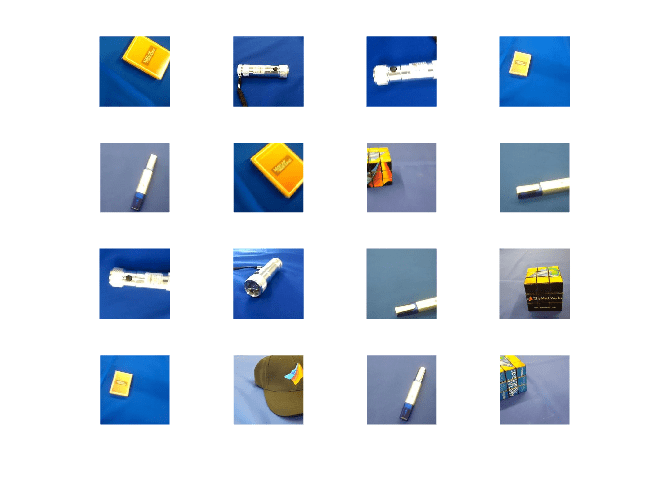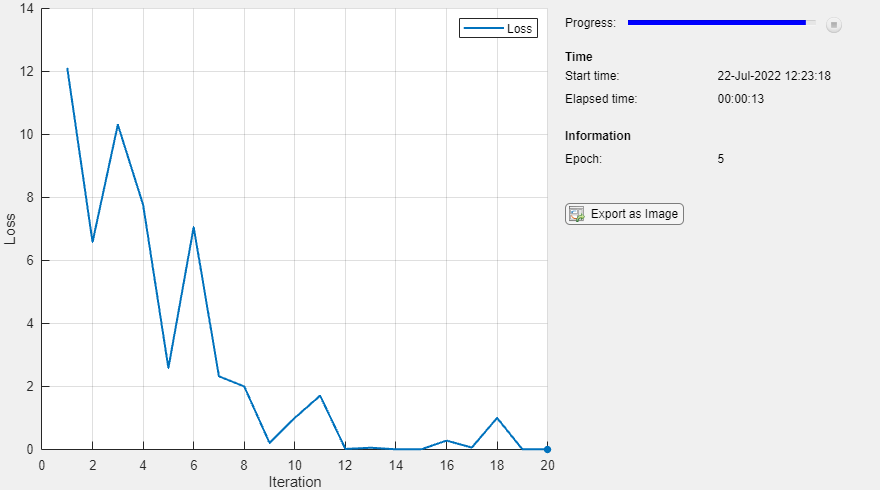ONNXParameters
Parameters of imported ONNX network for deep learning
Description
ONNXParameters contains the parameters (such as weights and
bias) of an imported ONNX™ (Open Neural Network Exchange) network. Use ONNXParameters to
perform tasks such as transfer learning.
Creation
Create an ONNXParameters object by using importONNXFunction.
Properties
Parameters updated during network training, specified as a structure. For example,
the weights of convolution and fully connected layers are parameters that the network
learns during training. To prevent Learnables parameters from being
updated during training, convert them to Nonlearnables by using
freezeParameters. Convert frozen parameters back to
Learnables by using unfreezeParameters.
Add a new parameter to params.Learnables by using addParameter.
Remove a parameter from params.Learnables by using removeParameter.
Access the fields of the structure Learnables by using dot
notation. For example, params.Learnables.conv1_W could display the
weights of the first convolution layer. Initialize the weights for transfer learning by
entering params.Learnables.conv1_W = rand([1000,4096]). For more
details about assigning a new value and parameter naming, see Tips.
Parameters unchanged during network training, specified as a structure. For example, padding and stride are parameters that stay constant during training.
Add a new parameter to params.Nonlearnables by using addParameter.
Remove a parameter from params.Nonlearnables by using removeParameter.
Access the fields of the structure Nonlearnables by using dot
notation. For example, params.Nonlearnables.conv1_Padding could
display the padding of the first convolution layer. For more details about parameter
naming, see Tips.
Network state, specified as a structure. The network State
contains information remembered by the network between iterations and updated across
multiple training batches. For example, the states of LSTM and batch normalization
layers are State parameters.
Add a new parameter to params.State by using addParameter.
Remove a parameter from params.State by using removeParameter.
Access the fields of the structure State by using dot notation.
For example, params.State.bn1_var could display the variance of the
first batch normalization layer. For more details about parameter naming, see Tips.
This property is read-only.
Number of dimensions for every parameter, specified as a structure.
NumDimensions includes trailing singleton dimensions.
Access the fields of the structure NumDimensions by using dot
notation. For example, params.NumDimensions.conv1_W could display the
number of dimensions for the weights parameter of the first convolution layer.
This property is read-only.
Name of the model function, specified as a character vector or string scalar. The
property NetworkFunctionName contains the name of the function
NetworkFunctionName, which you specify in importONNXFunction. The function NetworkFunctionName
contains the architecture of the imported ONNX network.
Example: 'shufflenetFcn'
Object Functions
addParameter | Add parameter to ONNXParameters object |
freezeParameters | Convert learnable network parameters in ONNXParameters to
nonlearnable |
removeParameter | Remove parameter from ONNXParameters object |
unfreezeParameters | Convert nonlearnable network parameters in ONNXParameters to
learnable |
Examples
Import the SqueezeNet convolution neural network as a function and fine-tune the pretrained network with transfer learning to perform classification on a new collection of images.
This example uses several helper functions. To view the code for these functions, see Helper Functions.
Unzip and load the new images as an image datastore. imageDatastore automatically labels the images based on folder names and stores the data as an ImageDatastore object. An image datastore enables you to store large image data, including data that does not fit in memory, and efficiently read batches of images during training of a convolutional neural network. Specify the mini-batch size.
unzip("MerchData.zip"); miniBatchSize = 8; imds = imageDatastore("MerchData", ... IncludeSubfolders=true, ... LabelSource="foldernames", ... ReadSize=miniBatchSize);
This data set is small, containing 75 training images. Display some sample images.
numImages = numel(imds.Labels); idx = randperm(numImages,16); figure for i = 1:16 subplot(4,4,i) I = readimage(imds,idx(i)); imshow(I) end

Extract the training set and one-hot encode the categorical classification labels.
XTrain = readall(imds);
XTrain = single(cat(4,XTrain{:}));
YTrain_categ = categorical(imds.Labels);
YTrain = onehotencode(YTrain_categ,2)';Determine the number of classes in the data.
classes = categories(YTrain_categ); numClasses = numel(classes)
numClasses = 5
SqueezeNet is a convolutional neural network that is trained on more than a million images from the ImageNet database. As a result, the network has learned rich feature representations for a wide range of images. The network can classify images into 1000 object categories, such as keyboard, mouse, pencil, and many animals.
Import the pretrained SqueezeNet network as a function.
squeezenetONNX() params = importONNXFunction("squeezenet.onnx","squeezenetFcn")
Function containing the imported ONNX network architecture was saved to the file squeezenetFcn.m. To learn how to use this function, type: help squeezenetFcn.
params =
ONNXParameters with properties:
Learnables: [1×1 struct]
Nonlearnables: [1×1 struct]
State: [1×1 struct]
NumDimensions: [1×1 struct]
NetworkFunctionName: 'squeezenetFcn'
params is an ONNXParameters object that contains the network parameters. squeezenetFcn is a model function that contains the network architecture. importONNXFunction saves squeezenetFcn in the current folder.
Calculate the classification accuracy of the pretrained network on the new training set.
accuracyBeforeTraining = getNetworkAccuracy(XTrain,YTrain,params);
fprintf("%.2f accuracy before transfer learning\n",accuracyBeforeTraining);0.01 accuracy before transfer learning
The accuracy is very low.
Display the learnable parameters of the network by typing params.Learnables. These parameters, such as the weights (W) and bias (B) of convolution and fully connected layers, are updated by the network during training. Nonlearnable parameters remain constant during training.
The last two learnable parameters of the pretrained network are configured for 1000 classes.
conv10_W: [1×1×512×1000 dlarray]
conv10_B: [1000×1 dlarray]
The parameters conv10_W and conv10_B must be fine-tuned for the new classification problem. Transfer the parameters to classify five classes by initializing the parameters.
params.Learnables.conv10_W = rand(1,1,512,5); params.Learnables.conv10_B = rand(5,1);
Freeze all the parameters of the network to convert them to nonlearnable parameters. Because you do not need to compute the gradients of the frozen layers, freezing the weights of many initial layers can significantly speed up network training.
params = freezeParameters(params,"all");Unfreeze the last two parameters of the network to convert them to learnable parameters.
params = unfreezeParameters(params,"conv10_W"); params = unfreezeParameters(params,"conv10_B");
The network is ready for training. Specify the training options.
velocity = []; numEpochs = 5; miniBatchSize = 16; initialLearnRate = 0.01; momentum = 0.9; decay = 0.01;
Calculate the total number of iterations for the training progress monitor.
numObservations = size(YTrain,2); numIterationsPerEpoch = floor(numObservations./miniBatchSize); numIterations = numEpochs*numIterationsPerEpoch;
Initialize the TrainingProgressMonitor object. Because the timer starts when you create the monitor object, make sure that you create the object immediately after the training loop.
monitor = trainingProgressMonitor(Metrics="Loss"); monitor.Info = ["LearningRate","Epoch","Iteration"]; monitor.XLabel = "Iteration";
Train the network.
epoch = 0; iteration = 0; executionEnvironment = "cpu"; % Change to "gpu" to train on a GPU. % Loop over epochs. while epoch < numEpochs && ~monitor.Stop epoch = epoch + 1; % Shuffle data. idx = randperm(numObservations); XTrain = XTrain(:,:,:,idx); YTrain = YTrain(:,idx); % Loop over mini-batches. i = 0; while i < numIterationsPerEpoch && ~monitor.Stop i = i + 1; iteration = iteration + 1; % Read mini-batch of data. idx = (i-1)*miniBatchSize+1:i*miniBatchSize; X = XTrain(:,:,:,idx); Y = YTrain(:,idx); % If training on a GPU, then convert data to gpuArray. if (executionEnvironment == "auto" && canUseGPU) || executionEnvironment == "gpu" X = gpuArray(X); end % Evaluate the model gradients and loss using dlfeval and the % modelGradients function. [gradients,loss,state] = dlfeval(@modelGradients,X,Y,params); params.State = state; % Determine the learning rate for the time-based decay learning rate schedule. learnRate = initialLearnRate/(1 + decay*iteration); % Update the network parameters using the SGDM optimizer. [params.Learnables,velocity] = sgdmupdate(params.Learnables,gradients,velocity,learnRate); % Update the training progress monitor. recordMetrics(monitor,iteration,Loss=loss); updateInfo(monitor,Epoch=epoch,LearningRate=learnRate); monitor.Progress = 100 * iteration/numIterations; end end

Calculate the classification accuracy of the network after fine-tuning.
accuracyAfterTraining = getNetworkAccuracy(XTrain,YTrain,params);
fprintf("%.2f accuracy after transfer learning\n",accuracyAfterTraining);0.99 accuracy after transfer learning
Helper Functions
This section provides the code of the helper functions used in this example.
The getNetworkAccuracy function evaluates the network performance by calculating the classification accuracy.
function accuracy = getNetworkAccuracy(X,Y,onnxParams) N = size(X,4); Ypred = squeezenetFcn(X,onnxParams,Training=false); [~,YIdx] = max(Y,[],1); [~,YpredIdx] = max(Ypred,[],1); numIncorrect = sum(abs(YIdx-YpredIdx) > 0); accuracy = 1 - numIncorrect/N; end
The modelGradients function calculates the loss and gradients.
function [grad, loss, state] = modelGradients(X,Y,onnxParams) [y,state] = squeezenetFcn(X,onnxParams,Training=true); loss = crossentropy(y,Y,DataFormat="CB"); grad = dlgradient(loss,onnxParams.Learnables); end
The squeezenetONNX function generates an ONNX model of the SqueezeNet network.
function squeezenetONNX() exportONNXNetwork(squeezenet,"squeezenet.onnx"); end
Import a network saved in the ONNX format as a function, and move the mislabeled parameters by using freeze or unfreeze.
Import the pretrained simplenet.onnx network as a function. simplenet is a simple convolutional neural network trained on digit image data. For more information on how to create simplenet, see Create Simple Image Classification Network.
Import simplenet.onnx using importONNXFunction, which returns an ONNXParameters object that contains the network parameters. The function also creates a new model function in the current folder that contains the network architecture. Specify the name of the model function as simplenetFcn.
params = importONNXFunction('simplenet.onnx','simplenetFcn');
A function containing the imported ONNX network has been saved to the file simplenetFcn.m. To learn how to use this function, type: help simplenetFcn.
importONNXFunction labels the parameters of the imported network as Learnables (parameters that are updated during training) or Nonlearnables (parameters that remain unchanged during training). The labeling is not always accurate. A recommended practice is to check if the parameters are assigned to the correct structure params.Learnables or params.Nonlearnables. Display the learnable and nonlearnable parameters of the imported network.
params.Learnables
ans = struct with fields:
imageinput_Mean: [1×1 dlarray]
conv_W: [5×5×1×20 dlarray]
conv_B: [20×1 dlarray]
batchnorm_scale: [20×1 dlarray]
batchnorm_B: [20×1 dlarray]
fc_W: [24×24×20×10 dlarray]
fc_B: [10×1 dlarray]
params.Nonlearnables
ans = struct with fields:
ConvStride1004: [2×1 dlarray]
ConvDilationFactor1005: [2×1 dlarray]
ConvPadding1006: [4×1 dlarray]
ConvStride1007: [2×1 dlarray]
ConvDilationFactor1008: [2×1 dlarray]
ConvPadding1009: [4×1 dlarray]
Note that params.Learnables contains the parameter imageinput_Mean, which should remain unchanged during training (see the Mean property of imageInputLayer). Convert imageinput_Mean to a nonlearnable parameter. The freezeParameters function removes the parameter imageinput_Mean from param.Learnables and adds it to params.Nonlearnables sequentially.
params = freezeParameters(params,'imageinput_Mean');Display the updated learnable and nonlearnable parameters.
params.Learnables
ans = struct with fields:
conv_W: [5×5×1×20 dlarray]
conv_B: [20×1 dlarray]
batchnorm_scale: [20×1 dlarray]
batchnorm_B: [20×1 dlarray]
fc_W: [24×24×20×10 dlarray]
fc_B: [10×1 dlarray]
params.Nonlearnables
ans = struct with fields:
ConvStride1004: [2×1 dlarray]
ConvDilationFactor1005: [2×1 dlarray]
ConvPadding1006: [4×1 dlarray]
ConvStride1007: [2×1 dlarray]
ConvDilationFactor1008: [2×1 dlarray]
ConvPadding1009: [4×1 dlarray]
imageinput_Mean: [1×1 dlarray]
Tips
The following rules apply when you assign a new value to a
params.Learnablesparameter:The software automatically converts the new value to a
dlarray.The new value must be compatible with the existing value of
params.NumDimensions.
importONNXFunctionderives the field names of the structuresLearnables,Nonlearnables, andStatefrom the names in the imported ONNX model file. The field names might differ between imported networks.
Version History
Introduced in R2020b
MATLAB Command
You clicked a link that corresponds to this MATLAB command:
Run the command by entering it in the MATLAB Command Window. Web browsers do not support MATLAB commands.
Select a Web Site
Choose a web site to get translated content where available and see local events and offers. Based on your location, we recommend that you select: .
You can also select a web site from the following list
How to Get Best Site Performance
Select the China site (in Chinese or English) for best site performance. Other MathWorks country sites are not optimized for visits from your location.
Americas
- América Latina (Español)
- Canada (English)
- United States (English)
Europe
- Belgium (English)
- Denmark (English)
- Deutschland (Deutsch)
- España (Español)
- Finland (English)
- France (Français)
- Ireland (English)
- Italia (Italiano)
- Luxembourg (English)
- Netherlands (English)
- Norway (English)
- Österreich (Deutsch)
- Portugal (English)
- Sweden (English)
- Switzerland
- United Kingdom (English)